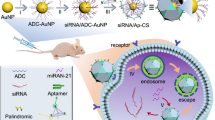Abstract
As drug targets, receptors have potential to screen drugs. Silica is an attractive support to immobilize receptors; however, the lack of biocompatibility makes it easier for receptors to lose bioactivity, which remains an obstacle to its widespread use. With the advantage of biocompatibility, DNA origami can be used as a biological carrier to improve the biocompatibility of silica and assemble receptors. In this study, a new biochromatography model based on DNA origami was constructed. A large quantity of M13ssDNA was used as a scaffold, leading to significant costs, so M13ssDNA was self-produced from the bacteriophage particles. This approach is demonstrated using the ligand binding domain of gamma isoform peroxisome proliferator-activated receptor (PPARγ-LBD) as a research object. PPARγ-LBD was assembled on DNA origami carrier and then coupled on the surface of silica. The products were packed into the column as stationary phase to construct the biochromatography with the ability to recognize drugs. Affinity and specificity of the biochromatography model were evaluated by HPLC. The final results showed that the biochromatography could recognize rosiglitazone specifically, which further proved that the model could screen chemical compositions interacted with PPARγ. It was the first time to take advantage of DNA origami to assemble PPARγ to construct biochromatography. The new biochromatography model has the advantages of being efficient, convenient, and high-throughput. This method affords a new way to rapidly and conveniently screen active ingredients from complex sample plant extracts and natural product-like libraries.







Similar content being viewed by others
References
Hu JJ, Du GH. A review on the advance of experimental assay methods and models in drug screening. Basic Med Sci Clin. 2001;21(4):302–5.
He L, Yang G, Geng X. Enzymatic activity and chromatographic characteristics of the cell membrane immobilized on silica surface. Chin Sci Bull. 1999;44(9):826–31.
Han SL, Zhang T, Huang J, Hu ZG, Wang SC. Screening target components from Radix salviae miltiorrhiae using an EGFR/CMC-online-HPLC/MS method. Anal Methods. 2012;4(4):1078–83.
Issemann I, Green S. Activation of a member of the steroid hormone receptor superfamily by peroxisome proliferators. Nature. 1990;347(6294):1155–208.
Evans RM, Barish GD, Wang YX. PPARs and the complex journey to obesity. Nat Med. 2004;10(4):355–61.
Temporini C, Pochetti G, Fracchiolla G, Piemontese L, Montanari R, Moaddel R, et al. Open tubular columns containing the immobilized ligand binding domain of peroxisome proliferator-activated receptors α and γ for dual agonists characterization by frontal affinity chromatography with mass spectrometry detection. J Chromatogr A. 2013;1284:36–43.
Rothemund PWK. Folding DNA to create nanoscale shapes and patterns. Nature. 2006;440(7082):297–302.
Marini M, Piantanida L, Musetti R, Bek A, Dong MD, Besenbacher F, et al. A revertible, autonomous, self-assembled DNA-origami nanoactuator. Nano Lett. 2011;11(12):5449–54.
Pilo-Pais M, Goldberg S, Samano E, LaBean TH, Finkelstein G. Connecting the nanodots: programmable nanofabrication of fused metal shapes on DNA templates. Nano Lett. 2011;11(8):3489–92.
Sharma J, Chhabra R, Cheng A, Brownell J, Liu Y, Yan H. Control of self-assembly of DNA tubules through integration of gold nanoparticles. Science. 2009;323(5910):112–6.
Zhao Z, Jacovetty EL, Liu Y, Yan H. Encapsulation of gold nanoparticles in a DNA origami cage. Angew Chem Int Ed. 2011;50(9):2041–4.
Pal S, Deng ZT, Ding BQ, Yan H, Liu Y. DNA-origami-directed self-assembly of discrete silver-nanoparticle architectures. Angew Chem Int Ed. 2010;49(15):2700–4.
Chhabra R, Sharma J, Ke YG, Liu Y, Rinker S, Lindsay S, et al. Spatially addressable multiprotein nanoarrays templated by aptamer-tagged DNA nanoarchitectures. J Am Chem Soc. 2007;129(34):10304–5.
Stein IH, Steinhauer C, Tinnefeld P. Single-molecule four-color FRET visualizes energy-transfer paths on DNA origami. J Am Chem Soc. 2011;133(12):4193–5.
Maune HT, Han SP, Barish RD, Bockrath M, Goddard WA, Rothemund PWK, et al. Self-assembly of carbon nanotubes into two-dimensional geometries using DNA origami templates. Nat Nanotechnol. 2010;5(1):61–6.
Ko SH, Gallatin GM, Liddle JA. Nanomanufacturing with DNA origami: factors affecting the kinetics and yield of quantum dot binding. Adv Funct Mater. 2012;22(5):1015–23.
Fu YM, Zeng DD, Chao J, Jin YQ, Zhang Z, Liu HJ, et al. Single-step rapid assembly of DNA origami nanostructures for addressable nanoscale bioreactors. J Am Chem Soc. 2013;135(2):696–702.
Acknowledgments
This work was supported by the National Natural Science Foundation of China (Grant No. 81402893 and 81573011).
Author information
Authors and Affiliations
Corresponding authors
Ethics declarations
Conflict of interest
The authors declare that they have no conflict of interest.
Electronic supplementary material
Below is the link to the electronic supplementary material.
ESM 1
(PDF 200 kb)
Rights and permissions
About this article
Cite this article
Zhou, J., Meng, L., Sun, C. et al. A new biochromatography model based on DNA origami assembled PPARγ: construction and evaluation. Anal Bioanal Chem 409, 3059–3065 (2017). https://doi.org/10.1007/s00216-017-0274-1
Received:
Revised:
Accepted:
Published:
Issue Date:
DOI: https://doi.org/10.1007/s00216-017-0274-1




